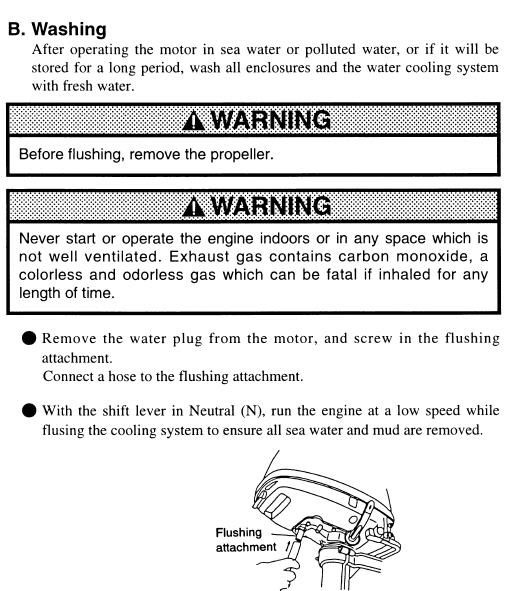Alex F
Well-Known Member
- Nov 14, 2006
- 9,166
- Boat Info
- 2005 420DB with AB 11 DLX Tender, Raymarine Electronics (2x12" MFDs) with Vesper AIS
- Engines
- Cummins 450Cs, 9KW Onan Generator, 40HP Yamaha for tender.
I just picked up 4HP Tohatsu 4-stroke motor and looking to winterize it. I read the manual, but still would like to clarify few things, since this is my first outboard.
- How do you guys flash the engine? It looks like there’s some kind of fitting that connects where the PEE comes out. Is this the right spot? Where do I get the fitting and how to get the plug out? What’s the proper way to flush the engine? I can’t understand how it works if I run the city water in to exhaust and run the engine. I'm guessing that I'm thinking of a wrong spot where the hose gets connected to, otherwise where would the exhaust come out?

- Do you guys use regular procedure to run the engine and use fogging oil to lubricate carburetor? Manual say to take the spark out and use storage oil. I’ve never used this method.
- Do you guys take all the fuel out of the tank (I have integral tank) as per manual or do you add fuel stabilizer? I’m concerned about the plastic tank and ethanol combination, which I’ve herd may cause damage to the tank.
Thanks for any suggestions,
Alex.
- How do you guys flash the engine? It looks like there’s some kind of fitting that connects where the PEE comes out. Is this the right spot? Where do I get the fitting and how to get the plug out? What’s the proper way to flush the engine? I can’t understand how it works if I run the city water in to exhaust and run the engine. I'm guessing that I'm thinking of a wrong spot where the hose gets connected to, otherwise where would the exhaust come out?

- Do you guys use regular procedure to run the engine and use fogging oil to lubricate carburetor? Manual say to take the spark out and use storage oil. I’ve never used this method.
- Do you guys take all the fuel out of the tank (I have integral tank) as per manual or do you add fuel stabilizer? I’m concerned about the plastic tank and ethanol combination, which I’ve herd may cause damage to the tank.
Thanks for any suggestions,
Alex.



